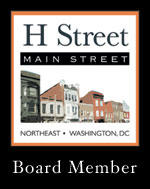(DC) Neighborhoods and commercial districts as brands
I can't remember the exact discussion, but commenter Charlie made the point that Georgetown and Capitol Hill are the DC city neighborhoods with the strongest brands.
 Georgetown has a strong identity as a neighborhood, as a place for tourists to visit, as a place to go out at night, with history and historic building stock, the university, and of course, for higher end shopping (although not as high end for the most part as Friendship Heights, which including the part in Maryland, has Neiman-Marcus, Saks Fifth Avenue and Bloomingdales as anchors). (See the past blog entry "Georgetown and chains and branding.")
Georgetown has a strong identity as a neighborhood, as a place for tourists to visit, as a place to go out at night, with history and historic building stock, the university, and of course, for higher end shopping (although not as high end for the most part as Friendship Heights, which including the part in Maryland, has Neiman-Marcus, Saks Fifth Avenue and Bloomingdales as anchors). (See the past blog entry "Georgetown and chains and branding.")Capitol Hill has a strong identity as a neighborhood, more locally focused--residents there raised a lot of money to support Eastern Market merchants after the 2007 fire destroyed their businesses, more home oriented, with the connections to the Capitol and House and Senate that have developed because of the proximity of the neighborhood.
On the right is a logo for Capitol Hill in Seattle. See "Meet the New Capitol Hill Logo!" from The Stranger alternative weekly. It could be better, it's just type, but maybe the trend in logos is to not have distinguishing imagery.
At the same time the various groups have to recognize that in terms of the end user, the overall Capitol Hill brand matters more than their individual brands, except maybe for Eastern Market. But there is a delicate dance between the US Capitol as a logo/identifier versus the various places of consumption that have nothing to do with the Capitol other than proximity.
So maybe come up with a common Capitol Hill branding logo, in which the individual groups can also incorporate their name.
Right: Fountain image of Dupont Circle by Rachel Cooper. The Dupont Circle fountain is an iconic monument that brands the Dupont Circle neighborhood.
Still, I got to thinking that there are other (potentially) "strong" brands in the city such as Adams-Morgan and H Street (who would have thunk it...) and U Street for nightlife; Cleveland Park, Chevy Chase, and to some extent Woodley Park for neighborhoods with commercial districts; "Anacostia" for good or bad as the major commercial district defining East of the River; urban villages like Brookland and Tenleytown; and Gallery Place (but do you call it Penn Quarter or Downtown?) especially because of the Verizon Center.
I don't know how to define exactly the identities for Dupont Circle, Downtown, and 14th Street. Friendship Heights is a shopping destination, but split between its DC and Maryland sides.
And Capitol Riverfront, which doesn't have the same zing as a name compared to Wrigleyville in Chicago or Fenway in Boston, is a brand under development, pushed forward of course by the Washington Nationals/baseball stadium as the central identity-making asset located there, which is more evident now that the Nationals are succeeding and drawing more fans (see "Capitol Riverfront draws permanent fans" from the Washington Examiner).
NoMA, like Capitol Riverfront they have to create an identity for a place constructed mostly of new buildings, but has a zingier name (and a good branding campaign). See "NoMA revisited: business planning to develop community."
And according to the Washington Post ("A “post-hippie” Takoma Park"), Takoma Park's brand (which is more complicated anyway because really, what people call "Takoma Park" is the "Old Town" or original part of the city, while the city "sprawls out" and goes up to University Boulevard and New Hampshire Avenue and in that part has a decidedly different character) is deteriorating as well.

Right: original H Street Main Street logo designed by Kevin O'Conner.
One of the problems with logos is defining what you are trying to communicate and to whom. A long time ago I read a book entitled Strategic Marketing for Not-for-Profit Organizations and it makes the point that all organizations have three publics: the input public that gives you resources; the throughput public of the staff and volunteers and other participants who produce what the organization does; and the output publics to whom the organization's various work products are directed.
Too often, logos and campaigns are designed for the throughput public--the people who make up the organization--not to the people who provide resources or the publics whom you are trying to reach (and change).
Also see "Design as a city branding strategy," "Town-City branding or "We are all destination managers now"," "The National Mall as a destination," and this piece from the Baltimore City Paper "Happy?: Baltimore's latest tourism campaign rekindles the city's ongoing branding issues."
Labels: branding-identity, commercial district revitalization, cultural heritage/tourism, destination management, tourism






1 Comments:
Thank you for providing such a valuable information and thanks for sharing this matter.to get Online pharmacy from Dose Pharmacy medicine.
Post a Comment
<< Home